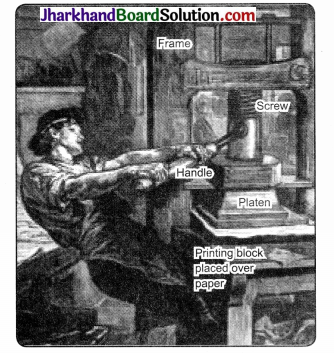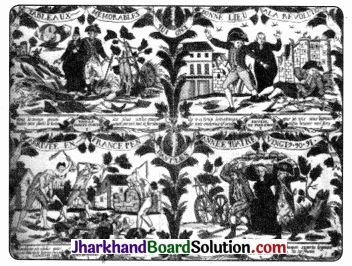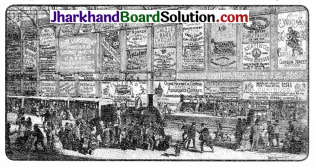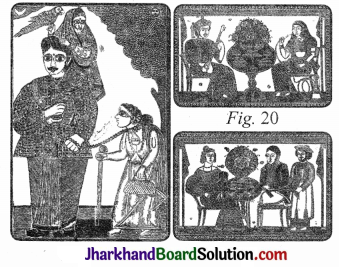JAC Board Class 7th Social Science Solutions Geography Chapter 5 Water
JAC Class 7th Geography Water InText Questions and Answers
Question 1.
Why water is important for us?
Answer:
Water is the most useful and easily available thing on the earth for the survival. It is useful in many ways. We require water for drinking, cleaning, washing, cooking, bathing, putting out fire, etc.
Question 2.
Suggest some ways in which water can be conserved in your home and in your school.
Answer:
Some ways in which water can be conserved in our home and in our school are:
- Use only the amount of water required.
- We should not play with water.
- We should repair the leakage taps.
- We should try to minimise the wastage of water.
- We should close the tap after use.
- Rainwater harvesting tequniques should be applied.
- We should not pollute water.
- Water recycling should be done.
JAC Class 7th Geography Wate Textbook Questions and Answers
Question 1.
Answer the following questions.
(i) What is precipitation?
Answer:
Precipitation is the falling of moisture in the form of rainfall, snow, fog, sleet and hailstorm.
![]()
(ii) What is water cycle?
Answer:
The process by which water continuously changes its form and circulates between oceans, seas, atmosphere and land is called as water cycle.
(iii) What are the factors affecting the height of the waves?
Answer:
The factors affecting the height of the waves are winds, earthquakes, under water disturbances, volcanic eruptions. The waves become bigger when the winds are stronger.
(iv) Which factors affect the movement of ocean water?
Answer:
The factors which affect the movement of ocean water are winds, temperature, gravitational pull of the sun, the earth and the moon. Apart from these, cold and warm currents also affect the movement of ocean current.
(v) What are tides and how are they caused?
Answer:
In a day, the rhythmic rise and fall of ocean or sea water which occurs twice are called as tides. They are caused by the strong gravitational pull exerted by the sun and moon on the surface of the earth.
(vi) What are ocean currents?
Answer:
The streams of water which flows constantly on the ocean’s surface in definite direction are called the ocean currents.
Question 2.
Give reasons.
(i) Ocean water is salty.
Answer:
Salt in the ocean comes from two sources: runoff from the land and openings in the seafloor. Rocks on land are the major source of salts dissolved in seawater. Rainwater that falls on land is slightly acidic, so it erodes rocks. Ocean water seeps into cracks in the seafloor and is heated by magma from the Earth’s core.
(ii) The quality of water is deteriorating.
Answer:
The quality of water is deteriorating because the portable water which is available is not always of good and pure in terms of quality. This is due to industrial effluents and outflow . and untreated water of factories and . industries get mixed into the rivers and streams. Sewer water also get mixed with them. Hence, it is unfit and poisonous for human and for other living being’s consumption.
Tick (√) the correct answer.
Question 3.
(i) The process by which water continually changes its form • and circulates between oceans, atmosphere and land
(a) Water cycle
(b) Tides
(c) Ocean currents
Answer:
(a) Water cycle
![]()
(ii) Generally the warm ocean currents originate near
(a) Poles
(b) Equator
(c) None of these
Answer:
(b) Equator
(iii) The rhythmic rise and fall of ocean water twice in a day is called
(a) Tide
(b) Ocean current
(c) Wave
Answer:
(a) Tide
Question 4.
Match the following.
| (i) Caspian Sea | (a) Largest lake |
| (ii) Tide | (b) Periodic rise and fall of water |
| (iii) Tsunami | (c) Strong seismic waves Streams of water |
| (iv) Ocean currents | (d) moving along definite paths |
| (e) Water cycle |
Answer:
| (i) Caspian Sea | (a) Largest lake Periodic rise |
| (ii) Tide | (b) and fall of water |
| (iii) Tsunami | (c) Strong seismic waves |
| (iv) Ocean currents | (d) Streams of water moving in along definite paths |
Question 5.
(For Fun) Be a Detective
(i) The name of one river is hidden in each of the sentences below. Spot it. Example: Mandira, Vijayalakshmi and Surinder are my best friends
Answer:
Ravi
(a) The snake charmer’s bustee, stables where horses are housed, and the piles of wood, all caught fire accidentally. (Hint: Another name for River Brahmaputra)
(b) The conference manager put pad, material for reading and a pencil for each participant. (Hint: A distributary on the Ganga-Brahmaputra delta)
(c) Either jealousy or anger cause a person’s fall (Hint: Name of a juicy fruit!)
(d) Bhavani germinated the seeds in a pot (Hint: Look for her in West Africa)
(e) “I am a zonal champion now” declared the excited atheletic. (Hint: The river that has he biggest basin in the world)
(f) The tiffin box rolled down and all the food fell in dusty potholes. (Hint: Rises in India and journeys through Pakistan)
(g) Malini leaned against the pole when she felt that she was going to faint. (Hint: Her delta in Egypt is famous)
(h) Samantha mesmerised everybody with her magic tricks. (Hint: London is situated on her estuary)
(i) “In this neighbourhood, please don’t yell! Owners of these houses like to . have peace”. Warned my father when . we moved into our new flat”. (Hint: colour!)
(j) ‘Write the following words, Marc!’ “On”, “go”, “in” said the teacher to the little boy in KG Class. (Hint: Rhymes with ‘bongo’). Now make some more on your own and ask your classmates to spot the hidden name. You can do this with any name: that of a lake, mountains, trees, fruits, school items, etc.
Answer:
(a) Teesta
(b) Padma
(c) Orange
(d) Niger
(e) Amazon
(f) Indus
(g) Nile
(h) Thames
(i) Yellow
(j) Congo
Carry on Detective
(ii) With the help of an atlas, draw each river which you discoverd in For fun (i), on an outline map of the world. Answer: Student need to do it on their own.
JAC Class 7th Geography Water Important Questions and Answers
Multiple Choice Questions
Question 1.
The word Tsunami derived from a Japanese word which means
(a) Ocean waves
(b) Harbour waves
(c) Ocean wind
(d) None of these
Answer:
(b) Harbour waves
Question 2.
World Water Day is celebrated on
(a) 22nd March
(b) 22nd May
(c) 24th March
(d) 28th July
Answer:
(a) 22nd March
![]()
Question 3.
The earth surface is …….covered by water.
(a) one-fourth
(b) one-third
(c) three-fourth
(d) half
Answer:
(c) three-fourth
Question 4.
The sources of fresh water are
(a) river, spring, salt lakes
(b) pond, river, glacier
(c) ocean, sea, river
(d) glacier, sea, river
Answer:
(b) pond, river, glacier
Question 5.
…….. has a saline water body.
(a) Glenwood Springs
(b) The Sambar lake
(c) The Amazon river
(d) None of these
Answer:
(b) The Sambar lake
Question 6.
The percentage of freshwater foundin rivers are
(a) 0.01%
(b) 0.00001%
(c) 0.001%
(d) 0.0001%
Answer:
(d) 0.0001%
Question 7.
A huge tidal wave is also called
(a) a Tsunami
(b) a tide
(c) a super wave
(d) all of these
Answer:
(a) a Tsunami
Question 8.
When the water covers much of the shore by rising to its highest level then the tide is called as
(a) Spring tide
(b) Neap tide
(c) Low tide
(d) igh tide
Answer:
(d) igh tide
Question 9.
The following is not a result of high tides
(a) generation of electricity
(b) growth of bananas
(c) better fishing
(d) better navigation
Answer:
(b) growth of bananas
Question 10.
The current which originates near the equator and moves towards the poles are
(a) warm ocean currents
(b) frozen ocean current
(c) cold ocean currents
(d) tidal ocean currents
Answer:
(a) warm ocean currents
Very Short Answer Type Questions
Question 1.
Which condition causes evaporation of water from earth’s surface?
Answer:
The condition which causes evaporation of water from earth’s surface is the sun’s heat.
Question 2.
Which place was the epicentre of the earthquake of 26th December, 2004?
Answer:
Sumatra was the epicentre of the earthquake of 26th December, 2004.
![]()
Question 3.
What was the magnitude of 26th December, 2004 earthquake?
Answer:
The magnitude of 26th December, 2004 earthquake was 9.0 on the Richter scale.
Question 4.
What happens in the areas where warm and cold current meet?
Answer:
The areas where warm and cold current meet, there they experience a foggy and misty weather which makes navigation very difficult.
Question 5.
Which place/s are the best fishing grounds in the world?
Answer:
The best fishing grounds in the world are the seas around eastern coast of North America and Japan.
Question 6.
What are the major sources of fresh water?
Answer:
The major sources of fresh water are river, lakes, springs, glaciers and ponds.
Question 7.
Is it possible to float in the Dead Sea? Why?
Answer:
Yes, it is possible to float in the Dead Sea because it becomes very dense by the increased salt contents.
Question 8.
From where cold currents originates?
Answer:
Cold current originates from the poles.
Question 9.
What do you mean by waves?
Answer:
The water of the ocean surface rises and falls alternatively, they are known as waves.
Question 10
Which is the southernmost point ofIndia? What happened in 2004?
Answer:
Indira point is the southernmost point of India. It submerged due to Tsunami in 2004.
Short Answer Type Questions
Question 1.
What happens during high tide and low tide?
Answer:
When high tide occurs waves rise very high and water covers much of the sea shore. When low tide occurs water falls to its lowest level and go back and recedes from the shore.
Question 2.
Define salinity? What is the salinity of seas and oceans?
Answer:
Salinity is the amount of salt in grams present in 1000 grams of water. The average salinity of the oceans is 35 parts per thousand.
![]()
Question 3.
Name the different types in which the movements of ocean w ater can be categorized.
Answer:
The movements of ocean water can be categorized as
- waves
- currents
- tides
Question 4.
What is the initial sign or indication of a tsunami?
Answer:
The initial sign or indication of a tsunami is that there is a rapid withdrawal and pull-out of water from the coastal region followed by destructive and disastrous wave.
Question 5.
What do you mean by spring tide and neap tide?
Answer:
Spring tides occurs during the full moon and new moon days, when the sun, the earth and the moon are in the same line and the tides are at its highest level.Neap tide occurs when the moon is in its first and last quarter, then the ocean water get drawn in diagonally opposite directions by the gravitational pull of sun and earth which results in low tides.
Question 6.
In which way waterbodies are distributed on the surface of the earth?
Answer:
The following table gives the distribution of water in percentage
| Saline water | Oceans | 97.3 |
| Fresh water | Ground water | 0.68 |
| Ice caps | 2.0 | |
| Fresh water lakes and Inland seas | 0.009 | |
| Salt lakes | 0.009 | |
| Atmosphere | 0.0019 | |
| Rivers | 0.0001 | |
| Total | 100.00 |
Question 7.
Differentiate between warm ocean current and cold ocean current.
Answer:
Difference between:
| Warm ocean currents | Cold ocean currents |
| • These originates near the equator and move towards the poles. | • These carry water , from the polar or higher latitudes to tropical or lower latitudes. |
| • Such as – The Gulf Stream | • Such as – The Labrador Ocean Current. |
| • It brings warm temperature over the surface of the land. | • It bring the cold temperature over surface of the land. |
Question 8.
Differentiate between waves and tides.
| Waves | Tides |
| • Waves happens all day long means 24 hours a day. | • Tides happens twice a day; once early morning and late at night. |
| • Due to the different actions of the wind, there are up and down movements of ocean water are called as waves. | • Due to the gravitational pull of the sun and the moon, there are up and down movement of ocean water are called as tides. |
| • The waves are not so useful’. As a matter of fact, they can be destructive and devastating. | • Tides are very useful. |
Question 9.
What do you understand by vertical circulation of ocean water.
Answer:
When the water surface gets heated by sun, water evaporates and increases the concentration of salts. Surface water becomes more dense and sinks and eventually sub-surface water rises up. Hence, the salinity of ocean water causes vertical circulation.
![]()
Question 10.
In which way Tsunami cause?
Answer:
A volcanic eruption, under water landslide, an earthquake shifts large amount of ocean water. Hence, huge and large waves are formed which are known as Tsunami.
Long Answer Type Questions
Question 1.
What are the important and major movements of ocean water?
Answer:
The important movements that occur in oceans can be classified as waves, tides and currents.
- Waves occurs when the water on the surface of the ocean rises and falls alternatively. Waves are formed when winds scrape and push across the ocean surface. The bigger the wave becomes when the stronger the wind blows.
- Tides are the rhythmic rise and fall of ocean water twice in a day. High tide occurs when water covers much of the shore by rising to its highest level. Low tide occurs, when water falls to its lowest level and recedes and move back from the shore. The strong gravitational pull exerted by the sun and the moon on the earth’s surface causes the tides.
- Ocean Currents are the streams of water flowing constantly on the ocean surface in definite directions. The ocean currents may be warm or cold. Normally, the warm ocean currents originate near the equator and move towards the poles. The cold currents carry water from polar or higher latitudes to tropical or lower latitudes. The Labrador Ocean current is cold current while the Gulf Stream is a warm current.
Question 2.
Explain in brief about Tsunami.
Answer:
Tsunami:
- Tsunami is a Japanese word which means ‘Harbour waves’ as the harbours get destroyed whenever there is tsunami.
- A volcanic eruption, an earthquake or underwater landslides can shift large amounts of ocean water.
- Hence, a huge tidal wave known as tsunami which may be as high as 15 m is formed. The largest tsunami ever measured was 150 m high. These waves travel at a speed of more than 700 km per hour.
- The tsunami of 2004 caused devastating and disastrous damage in the coastal areas of India. The Indira point in the Andaman and Nicobar islands got submerged after the tsunami.
- On 22nd December, 2018, huge, monstrous and gigantic waves crashed into the coastal areas of Java and Sumatra in Indonesia. The volcano named Anak Karakatau erupted again on the following day causing huge damage which took many lives.
- These damage caused to life and property are due to the lack of monitoring the early warning systems and knowledge among the coast dwellers.




